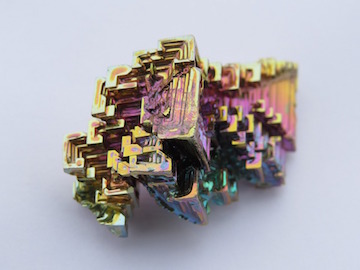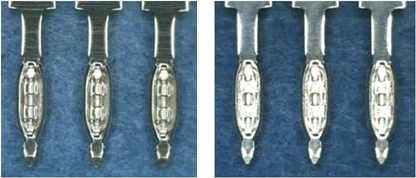New Plating Technologies Evolve as the Industry Gets the Lead Out
RoHS rules inspire innovative, electroplated press-fit solutions that eliminate tin and lead from the terminal plating and board mounting processes.
By Frank Schabert, Senior Manager Research and Erika Crandall, TE Connectivity
New Plating Technologies
Necessity inspires innovation. When the Reduction of Hazardous Substances (RoHS) rules on lead were adopted by the European Union in 2003, the connector industry needed to find new ways to provide products and solutions that would continue to meet customer requirements. One of the chief concerns was that the adoption of lead-free materials would lead to an increase of tin whiskers. These microscopic splinters from electronic contact pins present a real problem of an increased risk of electronic shorts. This is a particular challenge for the automotive industry. With car and truck makers putting more electronics and sensors into vehicles at ever-greater densities, a single tin whisker can present a real risk of conducting electricity across unrelated systems, and can easily cause costly and damaging product failures or recalls.

Bismuth
One solution: electroplated press-fit pins. Press-fit pins provide solderless (i.e., lead-free) terminal-to-PCB connectivity proven robust enough for harsh-environment automotive applications, and can be used in both headers and as single-pin solutions. Metallurgists at key connector companies have also devised new technologies that coat these pins with lead-free materials, rather than traditional tin/lead (SnPb) or 100% tin (Sn) plating materials. At TE Connectivity, a tin-free bismuth (Bi) compound is now used to electroplate the pins. Called LITESURF plating, this new process reduces whisker risk by a factor of more than 1,600 and yields an ideal product for automotive applications, including: airbag control units, anti-lock braking systems, electronic stability control systems, sensor systems, and engine management systems, including rapidly growing electric and hybrid electric management systems with increasingly sophisticated and complex control architectures.
Eliminating solder from the termination process offers a number of virtues. It significantly reduces thermal stress to the connectors before the system even hits the road, it reduces the overall use of hazardous substances, it provides customers with greater process control, and it eliminates the soldering mistakes of years past, like flux residuals and cold solder joints, which created quality control issues. TE Connectivity’s quality control system documents every PCB insertion, which yields further information advantages downstream in the vehicle service lifetime. Over years of investigation and testing, TE has found that a soldered connection is 10 times more likely to fail than a press-fit connection.
Due to the variety of plating and underplating options available for press-fit pins, the tin whisker challenge remains for many materials and plating processes. Bi-based plating provides a material deposition that behaves similarly to tin, but has nowhere near the whisker risk and is an affordable, non-toxic metal, which is essential for its long-term acceptance and application within electronic systems. TE’s Bi-based plating process also doesn’t require a nickel (Ni) underlayer or precious metal additives, which further reduces material cost and production time.

Figure 1: Two examples of tin whiskers protruding from compliant pins in plated through-holes. On the left, a scanning electron micrograph (SEM) image of a multi-spring pin. On the right, a stereo microscope image of a tin whisker spanning adjacent pins.
A Rigorous Testing Process Yields Confidence in New Process
The deposition process for the Bi-based LITESURF plating technology follows the typical galvanic plating line procedure and can be implemented without additional process changes. The multi-spring signal pins are reel-to-reel plated on a bronze alloy base material (CuSn6) using a fully-automated, in-house production line. After a visual inspection, the pins are inserted into PCBs before being subjected to subsequent testing. PCBs with immersion tin (iSn), immersion gold (iAg), and organic solderability preservative (OSP) surface finishes were all tested to confirm the effective application and compatibility of the Bi plating. Extreme minimum and maximum plated through-hole (PTH) diameters were also tested to demonstrate the high reliability of this Bi plating.

Figure 2: Multi-spring pins with Bi plating (left) and Sn plating (right).
For every PCB/PTH combination tested, at least 200 pins were investigated for whisker growth at room temperature and average humidity conditions after six and 12 weeks of storage. For iSn-plated PCBs, 300 pins were investigated due to the increased possibility of Sn whisker growth from the PTH. Press-in/pull-out forces were also recorded, and micro-sections of the pressed-in pins were inspected for PCB deformation.
Other tests included a series of extreme environmental exposures, such as thermal shock, a climate sequence, dry heat storage, and mixed-flow gas in separate PCBs, this time with 40 pressed-in pins tested for each PCB/PTH combination. The contact resistance was initially measured across every pin after press-in using the four-point-method and then consecutively after each sequential aging test. Directly after contact resistance measurements were taken, the PCBs were transferred to the next aging environment. The change in contact resistance after each individual aging test was recorded. After all of the environmental testing, the PCBs were again inspected for whisker growth.
All visual inspections, micro-sections, press-in/pull-out, and contact resistance measurements were executed in accordance with the IEC 60352-5 standard for solderless connections. However, the environmental aging tests went beyond this standard to account for global automotive applications, which demand robust, high-reliability systems that can endure intense mechanical and environmental conditions. All whisker imaging and length measurements were performed according to JEDEC Standard No. 22-A121A, and any pins found with whisker-like objects in an optical system were also investigated using a scanning electron microscope (SEM) to confirm validity.
All whisker growth investigations were divided between TE and an external company to ensure the authenticity of the results.
Since LITESURF plating is tailored to press-fit pin applications, one of the most important qualities for confirming a good electrical contact is a stable, reliable contact resistance. The highest recorded resistance increase found in testing was 0.23mΩ after the climatic sequence environment, which is less than half of the maximum accepted resistance increase (0.5mΩ) specified in IEC 60352-5, which effectively demonstrates the plating’s high reliability.
After all of the various incubation tests, ranging from radiographic testing (RT) to a series of extreme environmental exposures, were conducted, whisker growth was again investigated. Regardless of the PCB/PTH combination, the investigation of more than 2,500 Bi-plated pins did not yield a single whisker or whisker-like object over 100µm, whereas the investigation of only 300 thin (i.e., lower whisker risk) Sn-plated pins yielded 12 whiskers over 100µm long.
Therefore, it is clear that this newly developed Bi plating technology achieves a very dependable deposit, exhibits exceptional performance on press-fit pins with universal PCB compatibility, and reliably alleviates the risk of whisker-induced failures. Alhough it is not a 100% whisker-free technology, it demonstrates a remarkable new level of whisker risk reduction, reducing the possibility of whisker-induced failures by orders of magnitude in comparison to Sn plating.
Automotive Evolution Demands New Connector Technologies
With the increasing number of computers and sensor-driven systems being added to vehicles in this era of electric powertrains, autonomous driving, and in-vehicle connectivity, next-generation technology solutions are needed to enable continued innovation and to meet ever-more rigorous regulatory and sustainability standards. LITESURF plating represents a new high water mark for TE’s sustainability commitment and offers automotive design engineers a safe, new, high-performance solution for lead-free electronics.
Frank Schabert is senior manager R&D and Erika Crandall is senior product development engineer at TE Connectivity. Both are based in Bensheim, Germany. Learn more at TE Connectivity.
TE Connectivity, TE connectivity (logo) and LITESURF are trademarks. Other product and/or company names may be trademarks of their respective owners.





